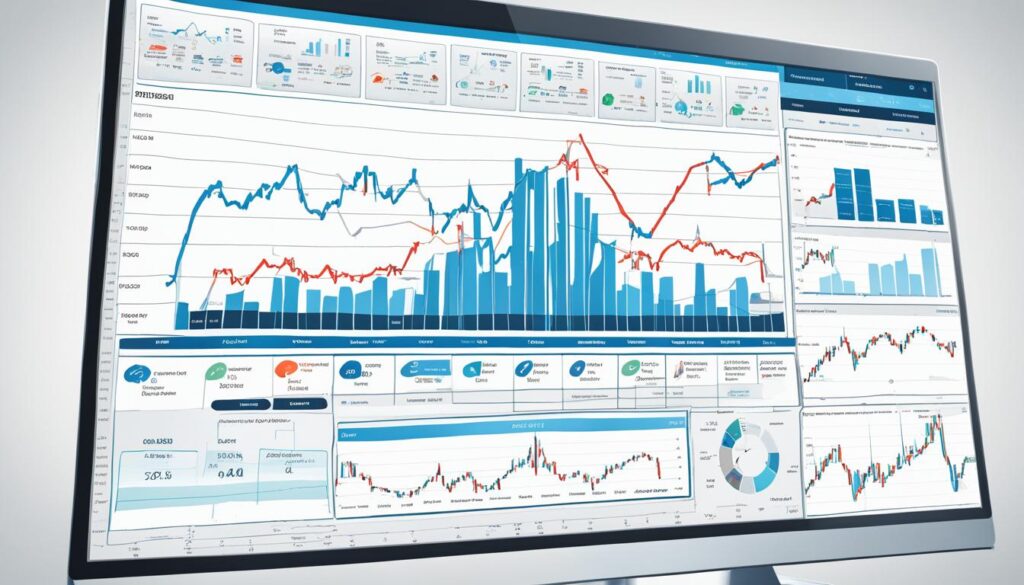DOM trading strategies have become the go-to choice for professional traders aiming to gain a market edge. In today’s increasingly complex and volatile market, these strategies offer advanced techniques that can optimize trading decisions and maximize profits. By incorporating insights and tips from experts, DOM trading strategies enable traders to stay ahead and achieve success.
Key Takeaways:
- DOM trading strategies provide professional traders with a competitive edge in the market.
- These strategies utilize insights from the Depth of Market (DOM) to make informed trading decisions.
- DOM trading strategies include techniques such as scalping, iceberg orders, stop orders, and order flow analysis.
- Implementing DOM trading strategies can enhance market edge and profitability.
- As the market evolves, DOM trading strategies remain crucial for sustained success.
Understanding DOM Trading Strategies
DOM trading strategies are based on understanding and utilizing the Depth of Market (DOM), also referred to as the order book. The DOM provides traders with real-time information about the current bid and ask price levels, as well as the number of buyers and sellers at each price level.
By analyzing this data, traders can make informed trading decisions, such as entering or exiting positions, based on the supply and demand dynamics in the market. DOM trading strategies enable traders to identify key support and resistance levels, track market momentum, and spot potential buying or selling opportunities.
These strategies are particularly useful in fast-moving markets where timing is crucial for success. An adept understanding of the DOM allows traders to gauge the market sentiment accurately and react swiftly to changes in price levels.
DOM trading strategies are a powerful tool in the hands of professional traders. By leveraging the information provided by the DOM, traders gain a crucial edge in the market, making precise trading decisions based on real-time order book dynamics.
For example, when analyzing the DOM, traders can observe clusters of buy orders at a particular price level, indicating strong demand. This insight can prompt them to enter a long position, anticipating a potential price increase. Conversely, they can identify areas of significant selling pressure and make informed decisions to short-sell or exit existing positions.
Tracking the DOM also allows traders to monitor the market depth and liquidity, making it easier to execute trades with minimal slippage. By assessing the number of buyers and sellers at different price levels, traders can strategically place their orders to enhance their chances of execution at favorable prices.
The DOM also provides essential information about the order flow, revealing the aggressiveness of buyers and sellers. This analysis allows traders to identify potential order imbalances and anticipate price movements before they happen, making them well-equipped to capitalize on market opportunities.
Case Study: Utilizing DOM Trading Strategies
Let’s explore a real-world example of how DOM trading strategies can be applied to gain a market edge:
| Date | Time | Bid DOM | Ask DOM | Price |
|---|---|---|---|---|
| March 15 | 10:12 am | 25 | 15 | $100.50 |
| March 15 | 10:14 am | 20 | 10 | $100.75 |
| March 15 | 10:16 am | 30 | 25 | $100.80 |
At 10:12 am, the DOM shows a bid of 25 and an ask of 15 with a price of $100.50. Analyzing the DOM, a trader might notice that the sellers seem to have the upper hand, as there are more sellers than buyers at this price level. This insight could prompt the trader to wait and observe before entering a long position.
At 10:14 am, the bid and ask decrease to 20 and 10, respectively, with the price increasing to $100.75. Now, the DOM shows a more balanced scenario, indicating a potential shift in market dynamics. The trader might consider entering a long position, anticipating a price increase based on the evolving order book.
Finally, at 10:16 am, the bid and ask increase to 30 and 25, respectively, with the price rising to $100.80. The DOM now suggests a stronger buyer presence, potentially indicating a higher demand. Based on this information, the trader might consider executing a long position, anticipating a further price rise.
This case study exemplifies how DOM trading strategies enable traders to analyze the market depth, track price levels, and anticipate potential movements. By leveraging the information provided by the DOM, traders can make informed decisions that align with their trading goals and maximize profitability.
In the next section, we will explore different types of DOM trading strategies that professional traders employ to optimize their trading performance.
Types of DOM Trading Strategies
There are different types of DOM trading strategies that professional traders employ to optimize their trading performance. These strategies are designed to take advantage of various aspects of market dynamics and order flow analysis. By understanding and implementing these strategies, traders can enhance their trading skills and improve their profitability.
1. Scalping
Scalping is a popular DOM trading strategy that involves making quick trades to capture small price movements. Traders who employ scalping strategies rely on the DOM to spot areas of liquidity and execute trades with minimal slippage. By taking advantage of short-term price fluctuations, scalpers aim to generate small but frequent profits. This strategy requires quick decision-making skills and a deep understanding of market dynamics.
2. Iceberg Orders
Iceberg orders are another widely used DOM trading strategy. In iceberg orders, large orders are split into smaller ones to hide the true size. By slowly revealing the order size, traders using iceberg orders can avoid triggering larger price movements and take advantage of market inefficiencies. This strategy helps traders maintain anonymity while executing large orders.
3. Stop Orders
Stop orders are a crucial component of DOM trading strategies. Traders can place stop orders to automatically execute a trade when a specific price level is reached. These orders help traders manage risk by allowing them to enter or exit positions at predetermined price levels. Stop orders can be used for both profit-taking and limiting losses, providing traders with increased control over their trades.
4. Order Flow Analysis
Order flow analysis is an integral part of DOM trading strategies. Traders analyze the volume and direction of orders to gain insights into market sentiment and potential price movements. By tracking the flow of orders, traders can identify areas of high demand or supply, spot potential reversals, and make informed trading decisions. Order flow analysis helps traders understand the dynamics of supply and demand in the market.
Conclusion
DOM trading strategies have emerged as the go-to choice for professional traders seeking a market edge. By harnessing the insights provided by the Depth of Market (DOM), traders can make more informed trading decisions and maximize their profitability. Whether it’s scalping, iceberg orders, stop orders, or order flow analysis, DOM trading strategies offer advanced techniques that give traders a competitive advantage in the fast-paced market.
In an ever-evolving market environment, DOM trading strategies remain a crucial tool for traders aiming for success. The DOM provides real-time information about bid and ask prices, as well as the number of buyers and sellers at each price level. This data helps traders identify key support and resistance levels, track market momentum, and uncover potential buying or selling opportunities.
If you’re looking to take your trading game to the next level, implementing DOM trading strategies is essential. These advanced techniques can unlock the power of the DOM and enhance your market edge. By optimizing your trading decisions based on DOM insights, you can stay ahead of the competition and increase your chances of success in the dynamic world of trading.
FAQ
What are DOM trading strategies?
DOM trading strategies are techniques employed by professional traders to gain a competitive edge in the market. These strategies utilize the Depth of Market (DOM) or order book to make informed trading decisions based on real-time bid and ask price levels as well as the number of buyers and sellers at each price level.
How can DOM trading strategies help optimize trading decisions?
DOM trading strategies enable traders to identify key support and resistance levels, track market momentum, and spot potential buying or selling opportunities. By utilizing the information provided by the DOM, traders can make more informed trading decisions and maximize their profitability.
What are some types of DOM trading strategies?
Some common types of DOM trading strategies include scalping, where traders make quick trades to capture small price movements; iceberg orders, where large orders are split into smaller ones to hide the true size; stop orders, which automatically execute a trade when a specific price level is reached; and order flow analysis, where traders analyze the volume and direction of orders to gain insights into market sentiment and potential price movements.
Why are DOM trading strategies the preferred choice for professional traders?
DOM trading strategies have become the preferred choice for professional traders due to their ability to provide a market edge. By utilizing advanced techniques and leveraging the information provided by the DOM, traders can optimize their trading decisions and enhance their profitability in an increasingly complex and volatile market.
How can I implement DOM trading strategies in my trading game?
To implement DOM trading strategies, it is important to familiarize yourself with the Depth of Market (DOM) and understand how it provides real-time information about bid and ask price levels and the number of buyers and sellers at each level. Additionally, learning about different DOM trading strategies such as scalping, iceberg orders, stop orders, and order flow analysis can help you enhance your market edge and make more informed trading decisions.
Source Links
Disclaimer
All information on this website is of a general nature. The information is not adapted to conditions that are specific to your person or entity. The information provided can not be considered as personal, professional or legal advice or investment advice to the user.
This website and all information is intended for educational purposes only and does not give financial advice. Signal Mastermind Signals is not a service to provide legal and financial advice; any information provided here is only the personal opinion of the author (not advice or financial advice in any sense, and in the sense of any act, ordinance or law of any country) and must not be used for financial activities. Signal Mastermind Signals does not offer, operate or provide financial, brokerage, commercial or investment services and is not a financial advisor. Rather, Signal Mastermind Signals is an educational site and a platform for exchanging Forex information. Whenever information is disclosed, whether express or implied, about profit or revenue, it is not a guarantee. No method or trading system ensures that it will generate a profit, so always remember that trade can lead to a loss. Trading responsibility, whether resulting in profits or losses, is yours and you must agree not to hold Signal Mastermind Signals or other information providers that are responsible in any way whatsoever. The use of the system means that the user accepts Disclaimer and Terms of Use.
Signal Mastermind Signals is not represented as a registered investment consultant or brokerage dealer nor offers to buy or sell any of the financial instruments mentioned in the service offered.
While Signal Mastermind Signals believes that the content provided is accurate, there are no explicit or implied warranties of accuracy. The information provided is believed to be reliable; Signal Mastermind Signals does not guarantee the accuracy or completeness of the information provided. Third parties refer to Signal Mastermind Signals to provide technology and information if a third party fails, and then there is a risk that the information may be delayed or not delivered at all.
All information and comments contained on this website, including but not limited to, opinions, analyzes, news, prices, research, and general, do not constitute investment advice or an invitation to buy or sell any type of instrument. Signal Mastermind Signals assumes no responsibility for any loss or damage that may result, directly or indirectly, from the use or dependence on such information.
All information contained on this web site is a personal opinion or belief of the author. None of these data is a recommendation or financial advice in any sense, also within the meaning of any commercial act or law. Writers, publishers and affiliates of Signal Mastermind Signals are not responsible for your trading in any way.
The information and opinions contained in the site are provided for information only and for educational reasons, should never be considered as direct or indirect advice to open a trading account and / or invest money in Forex trading with any Forex company . Signal Mastermind Signals assumes no responsibility for any decisions taken by the user to create a merchant account with any of the brokers listed on this website. Anyone who decides to set up a trading account or use the services, free of charge or paid, to any of the Broker companies mentioned on this website, bears full responsibility for their actions.
Any institution that offers a service and is listed on this website, including forex brokers, financial companies and other institutions, is present only for informational purposes. All ratings, ratings, banners, reviews, or other information found for any of the above-mentioned institutions are provided in a strictly objective manner and according to the best possible reflection of the materials on the official website of the company.
Forex/CFD trading is potentially high risk and may not be suitable for all investors. The high level of leverage can work both for and against traders. Before each Forex/CFD investment, you should carefully consider your goals, past experience and risk level. The opinions and data contained on this site should not be considered as suggestions or advice for the sale or purchase of currency or other instruments. Past results do not show or guarantee future results.
Neither Signal Mastermind Signals nor its affiliates ensure the accuracy of the content provided on this Site. You explicitly agree that viewing, visiting or using this website is at your own risk.




